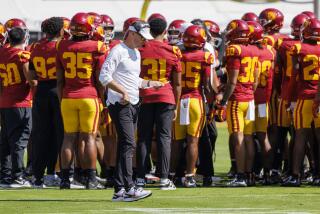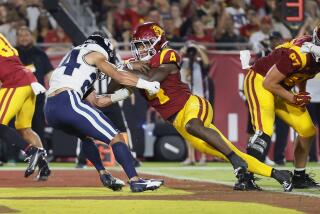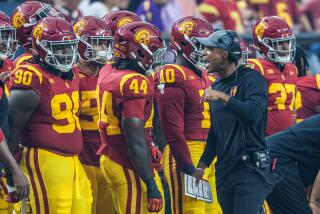Carroll Sells
Shortly after noon, Pete Carroll leaves his office and hurries outside to where an assistant waits with a golf cart. There is much to do in preparation for Saturday’s game but, at the moment, he must head across campus to speak to a weekly gathering of boosters.
A student calls out as he rides past and, the moment he steps off the cart, a small girl stops him for an autograph. Her mother chimes in: “If she were older and you were younger, she’d want you forever.” Finally Carroll strides into the luncheon and all those well-heeled fans erupt in raucous applause.
It has been a while since a football coach was this popular on the USC campus and Carroll knows it. “This is pretty sweet,” he says.
Fewer than two years after arriving to a chorus of skeptics -- Could a guy with a lukewarm record in the NFL, a guy almost two decades removed from the college game, do the job? -- Carroll has returned USC to a hint of its glory days.
A big win over UCLA last week pushed the Trojans to 9-2 and No. 6 in the polls, their best standing this late in the season since 1988. A victory over Notre Dame at the Coliseum on Saturday could nudge them into a coveted bowl championship series game.
It’s only one season. Carroll and everyone else in the athletic department repeats this mantra. But alumni and fans, even players, find it hard not to be giddy over the reversal of fortune.
“This is so much fun,” says cornerback Marcell Allmond, a junior who has never been on a winning team until now. “This is what Coach Carroll has brought.”
*
What Carroll brought to USC, at first, were doubts.
Fans on the West Coast knew him vaguely as a coach who had been to the playoffs but had been fired from the New York Jets and New England Patriots. They knew his image in the media as smart but quirky, mixing football with psychology and philosophy, too friendly with players, too soft.
“He never got the respect he deserved in the NFL,” says University of Pittsburgh Coach Walt Harris, a longtime friend. “I always told him, Pete, you’d be a great college coach.”
Arriving at USC in December 2000, Carroll pledged to adjust -- not change -- his style. He proved it immediately, gathering his team at the Coliseum one night for a surprise tug-of-war.
Players learned they could talk to him about their families and girlfriends. He liked to play catch after practice and rock music often reverberated from his office.
“The coaches can be sitting in a meeting room, in the deepest discussion about the most important thing, but the second a player walks in the door, the discussion stops,” says assistant Ed Orgeron, a holdover from the previous staff of Paul Hackett. “The players know they can talk to us.”
The key to Carroll is his belief that he cannot succeed in the traditional roles of coach as tyrant or chief executive directing the team from on high. He operates face-to-face, doubling as defensive coordinator because it gives him an opportunity to work hands-on, teaching technique, proving himself daily.
“I know it sounds like a cliche, but he has this great relationship with his players,” cornerback Darrell Rideaux says. “They want to play hard for him.”
The defense is an example. Though the Trojans have All-American safety Troy Polamalu, they had to replace much of the secondary and lost standout tackle Shaun Cody to injury. The squad has overachieved, ranking fifth in the nation against the run and 14th overall.
“It isn’t so much Xs and O’s because I think Paul Hackett is as good at Xs and O’s as anyone,” Washington State Coach Mike Price says. “I think it’s chemistry.”
Carson Palmer agrees. “He brought his intensity and his love and his passion for the game,” the USC quarterback says. “That has really rubbed off ... everybody is fired up, jumping up and down on the sideline. Guys on the field are happy, flying around and slapping each other. That’s Coach Carroll.”
Perhaps his friends were right -- his buoyant persona is better suited to the youth and enthusiasm of the college game. Offensive coordinator Norm Chow explains: “It’s refreshing and it’s never going to get old because the players keep turning over.”
Carroll sees another benefit to his new surroundings. He claims to have been handcuffed in New England by a front office that dictated the roster. Whether or not this contributed to his woes -- he was accused of losing control of the team -- Carroll relishes the authority to recruit players and discipline them without having to yell or grab facemasks.
“If you’re out of control or doing something wrong, he pulls you aside,” offensive lineman Lenny Vandermade says. “He lets you know that if you keep doing that, you won’t play.”
This season, in the statistical categories most closely linked to discipline, the Trojans are committing seven penalties a game and rank ninth in the nation in turnover margin, both significant improvements over the previous staff. And the coach has been free to tinker with his lineup.
Matt Grootegoed was switched from safety to linebacker and, though undersized, leads the team in tackles. Allmond, a receiver his first three seasons, has helped plug the hole at cornerback, intercepting his first pass against UCLA.
A month ago, though Sultan McCullough ranked third in the conference in rushing, Carroll decided to start Justin Fargas at tailback. The switch was so unexpected that some players did not know about it until the offense huddled before the first snap.
Fargas responded by running for 139 yards in a critical victory at Oregon. Carroll downplays the move -- “A gut feeling ... sometimes they work, sometimes they don’t” -- but does not take his newfound autonomy for granted.
“I like the control,” he says. “It’s so much easier to coach the way I want to.”
Still, reviving a beleaguered USC program required one more piece to the puzzle. Oddly enough, the problem was offense, which was supposed to be the team’s strength.
Not only did Carroll inherit Palmer, McCullough and receiver Kareem Kelly, he paid $300,000 a year for Chow, who spent 27 years grooming quarterbacks at Brigham Young. As Price says, “it was the right kind of fit ... he went out and got an offensive coordinator who knows how to throw the ball as well as anybody in the country.”
Yet the Trojans finished as the worst offensive team in the conference last season. Even when a late winning streak put them in the Las Vegas Bowl, they suffered an embarrassing 10-6 loss to Utah, a game in which Palmer et al looked hapless.
So Carroll and Chow made changes.
The drop-back offense was shelved in the off-season, replaced by more play-action passes, more rollouts. Alex Gibbs, the Denver Bronco offensive line coach, was brought in to share his philosophy on blocking.
This fall, a revamped line has helped the Trojans add 34 yards a game on the ground, boosting their average to a respectable 129. That, in turn, has helped Palmer sell those play-action fakes, giving him time to find open receivers.
USC ranks 10th in the nation in passing and 16th in total offense, statistics that have made the quarterback a Heisman Trophy candidate.
The offense has also benefited from several of those freshmen Carroll gets to recruit. He loves traveling around the country, sitting in living rooms, trying to persuade young athletes. Again, it’s the eye-to-eye contact. Last spring, he attracted one of the nation’s top-rated classes.
Winston Justice starts at tackle. Tailback Hershel Dennis scored on a long run against UCLA. Most significant, receiver Mike Williams has changed the dynamic of the passing game, a big and physical counterpoint to Kelly and Keary Colbert.
“This is what I love,” Carroll says. “I’m in charge. I can go get the players I need.”
*
The stereo is tuned to a rock ‘n’ roll station, the Rolling Stones thumping from speakers, when Carroll returns to his office after the booster luncheon. Several people wait in the lobby but his time is tight.
“Notre Dame,” he says. “We’ve got to keep this thing rolling.”
It seems as if the coach is making up for lost time. Carroll believes he could have won more games in New England if given the freedom to run the team his way. Instead, after leading the Patriots to the playoffs twice, he was fired when they fell to 8-8 in his third season.
The ensuing year was spent away from coaching, rethinking all he had done right and wrong, visiting with Harris and others to get a sense of the college game. By the fall 2000, he was prepared for another shot.
USC talked to bigger names -- Oregon State’s Dennis Erickson, Oregon’s Mike Bellotti, then-San Diego Charger coach Mike Riley -- but athletic department officials rave about Carroll’s interview. “I saw someone who was a teacher and knew his craft,” Athletic Director Mike Garrett said. “I thought, ‘This guy is pretty good.’ ”
Outsiders had their doubts.
Alumni grumbled. The media portrayed Carroll as a twice-fired retread, an NFL veteran out of touch with the college game. Two years later, he has a chance to say “I told you so” but declines with a shrug.
“It’s all right,” he says. “I expected all that.”
Of greater concern is Notre Dame’s sturdy defense. And, with signing day drawing nearer, Carroll has another recruiting class to think about. There is too much work to be done -- too much fun -- for him to be waylaid by the hoopla of this current success.
“It’s just one season,” he says. But he says it with a tone of confidence, the manner of a man who believes he has paid his dues and knows exactly where he is heading.
*
(BEGIN TEXT OF INFOBOX)
Second Time Around
In his second season, Pete Carroll has coached the Trojans to a 9-2 record and a No. 6 Associated Press poll ranking heading into Saturday’s showdown with Notre Dame. A look at how the last six USC coaches did in their second seasons:
*--* Coach Year Rec AP Rk Pete Carroll 2002 9-2 6 Paul Hackett 1999 6-6 NR John Robinson 1994 8-3-1 13 Larry Smith 1988 10-2 7 Ted Tollner 1984 9-3 10 John Robinson 1977 8-4 13 John McKay 1961 4-5-1 NR
*--*
More to Read
Go beyond the scoreboard
Get the latest on L.A.'s teams in the daily Sports Report newsletter.
You may occasionally receive promotional content from the Los Angeles Times.







